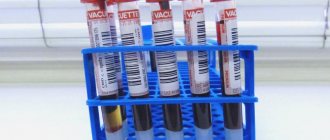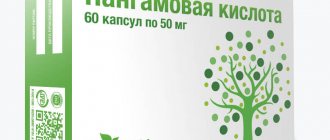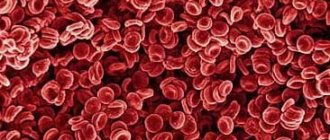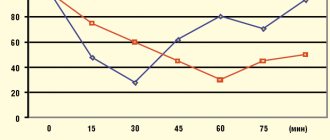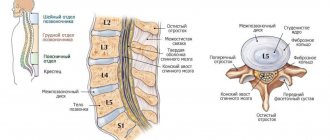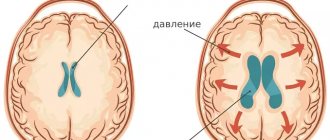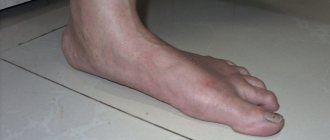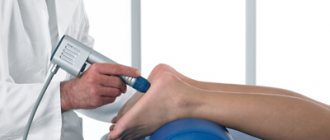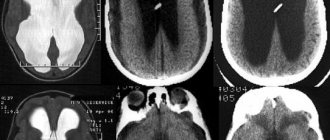In a healthy state, the body produces the substance during the processing of proteins and removes it through the gastrointestinal tract and kidneys. Uric acid can be elevated if there is a failure in its elimination or if it is over-produced by the liver.
An analysis for the determination of uric acid in the blood is important in the diagnosis of kidney diseases, gout, arthrosis and arthritis, since over time it transforms into crystals that accumulate in the joints, kidneys, gastrointestinal tract, heart and eye chambers.
Classification
Based on etiology, there are 2 main types of hyperuricemia:
- Primary
- occurs due to a genetically determined defect in enzymes involved in the metabolism of uric acid. - Secondary
– develops against the background of certain diseases, the action of toxins, medications, etc.
According to pathogenesis, there are 3 types of hyperuricemia:
- Metabolic (hyperproductive
) - associated with increased formation of uric acid. - Renal (hypoexcretory
) - due to a slowdown in the release of uric acid from the body in the urine. - Mixed.
According to clinical manifestations there are:
- asymptomatic hyperuricemia;
- acute/intermittent arthritis;
- interictal period;
- chronic tophi gout.
Consequences
High levels of uric acid in the blood provoke the most common disease - gout. Increased changes in indicators are indicated by inflammation of the joints and arthritis. These diseases are accompanied by acute pain for those who suffer from them. A person may become disabled for this reason.
Hyperuricemia significantly increases the risk of gout progression, since uric acid tends to accumulate in the blood with the subsequent formation of microscopic crystals in the joints. These particles tend to penetrate the synovial joints and thereby cause pain. It occurs during movement when friction occurs.
Causes
Physiological reasons
In healthy people, transient or slight increases in uric acid (UA) concentrations may occur without any clinical symptoms. Most often, hyperuricemia is observed when eating meat foods, since meat products are rich in purine bases (adenine, guanine), which are a substrate for the synthesis of uric acid. Hyperuricemia also occurs with dehydration, intense physical activity, and alcohol intake.
Gout
This rheumatological disease can be considered a clinical manifestation of hyperuricemia. Gout develops as a result of a genetically determined defect in enzymes that regulate UA metabolism. Such defects include deficiency of hypoxanthine-guanine phosphoribosyltransferase and increased activity of 5-phosphoribosyl-1-synthetase. Violation of the functional activity of these enzymes leads to increased synthesis of uric acid.
In peripheral tissues, especially in joint capsules and cartilage, crystallization of uric acid salts occurs and their deposition. As a result, the following symptoms appear: acute, intense pain in the joints (usually in the first metatarsophalangeal joint), swelling of the joint with redness of the skin. A fairly specific symptom of gout is the formation of nodules - tophi, localized mainly on the auricles and the back surface of the elbow joints. Gout can also develop against the background of diseases that affect purine metabolism.
Hyperuricemia
Overproduction of uric acid
With intensive destruction of cells and their nuclei, nucleotides are released, from which a large amount of MK is subsequently formed, which leads to an increase in the level of MK. The presence of clinical symptoms of emerging hyperuricemia is determined by the degree of tissue destruction. Increased catabolism is observed in the following diseases and pathological conditions:
- Myeloproliferative and lymphoproliferative diseases (leukemia, lymphoma).
- Tumor lysis syndrome after chemotherapy courses.
- Congenital and acquired hemolytic anemia.
- Severe generalized psoriasis.
- Storage diseases: Gaucher disease, glycogenosis.
Slow elimination of uric acid
Approximately 2/3 of the total amount of MK is excreted in the urine. Therefore, any violation of the excretory function of the kidneys due to their organic damage can lead to hyperuricemia. The same thing often happens when the effective blood volume decreases, which disrupts the blood supply to the kidneys. The following are the main reasons for the suppression of uric acid clearance:
- Glomerulonephritis.
- Interstitial nephritis.
- Chronic renal failure.
- Massive bleeding.
- Congestive heart failure.
- Lead poisoning (lead nephropathy).
- Taking thiazide diuretics.
Other reasons
- Endocrine disorders: hypoparathyroidism, hypothyroidism.
- Diabetic ketoacidosis.
- Lactic acidosis.
- Preeclampsia.
- Sarcoidosis.
- Taking medications: acetylsalicylic acid, cytotoxic drugs (cyclosporine, sodium mycophenolate), anti-tuberculosis drugs (ethambutol, pyrazinamide), nicotinic acid.
Are there benefits to elevated uric acid levels?
Many are surprised by the fact that some researchers are convinced that a high level of purine metabolic product in the blood has a positive effect on the body and makes it possible to correct certain pathological conditions:
- Back in the 1960s and 1970s, numerous studies were conducted and it was proven that patients with acute hyperuricemia have a higher level of intelligence and reaction acuity. This is explained by the fact that uric acid is similar in chemical structure to trimethylated xanthine caffeine. Therefore, researchers believe, it influences increased performance.
- Higher-than-average acid levels have been shown to prolong life while acting as an antioxidant that inhibits superoxide and peroxynitrite, iron-catalyzed oxidative reactions. Increased antioxidant activity and activation of endothelial function occurs as a result of uric acid transfusion.
- This compound is a powerful neuroprotector, inhibitor of neuroinflammation and neurodegeneration. It also significantly reduces the risk of Alzheimer's and Parkinson's diseases.
It should be noted that a characteristic effect occurs with a sharp increase in acid in the blood. Chronic hyperuricemia has other consequences: endothelial dysfunction and the development of the oxidative process.
Along with the positive effect of raising the level of uric acid in the blood, its high level is a serious signal about a number of diseases. It is necessary to immediately conduct a series of studies that will help establish the causes and cancel them. Uric acid in excess is a poison that poisons the body from the inside.
Diagnostics
If hyperuricemia is detected, you must consult a general practitioner to determine the cause of its occurrence. At the appointment, the presence of symptoms characteristic of this condition is clarified. The joints that are bothering the patient are carefully examined for swelling or redness. It is determined whether the patient has any chronic diseases, whether he is registered with a dispensary, and what medications he takes. An additional examination is prescribed, including:
- Blood tests.
During a gout attack with severe symptoms, a general blood test shows an increase in ESR and neutrophilic leukocytosis. In biochemical analysis, in addition to hyperuricemia, inflammatory markers are detected (increased C-reactive protein, ferritin); in patients with renal pathology, increased concentrations of creatinine and uric acid are detected. - General urine analysis.
Microscopic examination of urine sediment reveals a large number of urate crystals. In nephrological patients, a chemical analysis of urine may reveal protein, red blood cells, and a change in its relative density. - Study of joint fluid.
To obtain synovial fluid, a puncture of the affected joint is performed. In the native unstained preparation, needle-shaped crystals of monosodium urate are detected by polarization microscopy. This is the gold standard for diagnosing gout. These crystals can also be found in the contents of tophi. - X-ray of joints.
X-ray changes in patients with gout appear only several years after the onset of the disease. Typical radiographic findings include well-defined bone defects in the epiphyses of the feet and hands.
Diet for hyperuricemia
What is urate, and how is it different from uric acid?
During the breakdown of purines in the liver, crystals are formed consisting of oxygen and carbon, nitrogen and hydrogen, that is, uric acid. It is excreted from the human body by the kidneys. Certain foods contain purines, including legumes, liver, beer and anchovies. This compound is found in small quantities in urine, blood, sweat, liver and brain tissue. The sodium and potassium salts of uric acid that form sediment in the urine are called urates. They are synthesized from this compound. Uric acid levels are tested in two ways: in urine and in blood. In the first case, a urine test is performed, in the second, a biochemical blood test is performed.
The presence of an acceptable dose of this substance does not pose any harm to the human body; on the contrary, it is involved in a number of important physiological functions:
- It increases the degree of influence of catecholamines on the cells of the body’s tissues, stimulating the functioning of the brain and various parts of the nervous system.
- Prevents the degree of negative effects of radicals on the body.
- Performs control over the qualitative composition of body cells.
Correction
Drug treatment
To correct hyperuricemia, it is necessary to eliminate the etiological factor. If, during the collection of anamnesis, it turns out that the patient is taking a drug that causes hyperuricemia, one should consider either reducing the dosage or replacing the drug with an alternative one that does not have such side effects. Treatment tactics are largely determined by the presence of clinical symptoms, as well as their severity.
- Diet.
People suffering from gout should definitely stop drinking alcohol and exclude high-purine foods (red meat, liver, smoked meats) from their diet, as they can provoke an increase in symptoms. - Colchicine alkaloids.
The main group of drugs for the relief of acute gout attacks. Reduction of symptoms occurs within 12 hours after the first dose. - NSAIDs.
Prescribed in addition to colchicine alkaloids to relieve arthritis symptoms. Preference is given to drugs with the most pronounced analgesic and anti-inflammatory effect. - Glucocorticosteroids.
Hormonal drugs are used to eliminate symptoms in case of individual intolerance to colchicine and NSAIDs or if the patient has strict contraindications to their use. - Uricodepressors.
Drugs in this group reduce the content of UA by suppressing the activity of the enzyme involved in the synthesis of UA (xanthine oxidase). Long-term use helps reduce the incidence of gout symptoms, slow down the deposition of crystals and the formation of tophi. - Selective xanthine oxidase inhibitors.
The main difference from uricodepressors is the lower incidence of unwanted side reactions, such as upper and lower respiratory tract infections, hepatotoxicity, and hypersensitivity reactions. - Uricosuric drugs.
These drugs inhibit the reabsorption of sUA in the renal tubules, thereby increasing the excretion of sUA. - Anti-gout drugs of mixed action.
There are also combination drugs that simultaneously act on 2 levels of urinary magnesium metabolism. They contain a uricodepressive component and a uricosuric agent. - Alkalizing drugs.
To prevent the development of urate nephropathy and the deposition of urate stones, the main urate-lowering therapy should be supplemented by taking drugs to alkalinize urine - sodium citrate, sodium bicarbonate.
Experimental therapy
Development and clinical trials of new drugs to combat hyperuricemia continue. Rasburicase, a drug containing recombinant uricase (an enzyme that destroys uric acid), has shown high effectiveness in the treatment of tumor lysis syndrome. This drug is also distinguished by the possibility of resorption of deposited sodium monourate crystals.
Promising is the use of genetically engineered biological drugs - an antagonist of interleukin-1 receptors (anakinra), fully humanized monoclonal antibodies to IL-1-beta (canakinumab), soluble protein IL-1 (rilonacept). Their use has demonstrated sufficient effectiveness in preventing exacerbations of symptoms of chronic gouty arthritis.
Gout symptoms
From Greek, gout is translated as “foot in a trap,” since the patient is primarily bothered by intense pain in the first metatarsophalangeal joint of the foot, knee or ankle.
It is also possible to involve the hand in the form of oligo or polyarthritis (inflammation of two or many joints). In this case, the joint becomes swollen, the skin above it acquires a red tint and begins to shine. This form of the disease is called acute gouty arthritis. The first clinical manifestations of the pathology may be preceded by a long asymptomatic period of hyperuricemia, when disorders are detected only by laboratory blood tests.
The first attacks of pain occur suddenly, mainly in the early morning or at night, tend to increase on the first day and completely disappear within a few hours or within a day. During an exacerbation of gout, signs of intoxication may also be present - increased body temperature, chills, weakness. After inflammation subsides, gouty arthritis occurs again, usually within six months to two years. As the disease progresses, the duration of periods of its asymptomatic course decreases, joint pain occurs more often and is more difficult to tolerate.
When going into a chronic form, gouty arthritis is accompanied by deformation and limitation of movements in the joints, pain of varying intensity becomes constant. Subsequently, deposits of uric acid crystals become visible. Under the skin, most often in the joint area, tophi appear - white or yellow nodules with crumbly, curdled contents. The formation of ulcers and purulent wounds is possible over them.
Hyperuricemia is accompanied by frequent exacerbations of concomitant diseases - coronary artery disease, diabetes mellitus, arterial hypertension, atherosclerosis. If gout complications develop, their characteristic symptoms are added. For urolithiasis, this is nagging pain in the lower back, periodic appearance of blood in the urine, and frequent urination at night. With a prolonged course of chronic tophi gout, the articular cartilage is destroyed, limitation of joint mobility persists outside periods of exacerbation, and complete fusion of the joint space with the formation of ankylosis (complete immobility of the joint) is possible. Depression can also be a consequence of constant pain.
